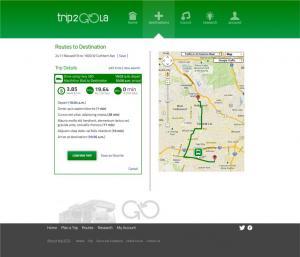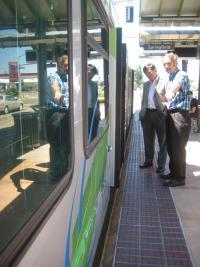Modal Applications
The PATH Modal Applications Program focuses on developing new concepts, methods, and technologies for offering more reliable and efficient transit options and for better balancing the demand and supply of the entire transportation system for the purpose of reducing traffic congestion, fuel consumption, and improved sustainability. In addition to providing sound research and testing capabilities, PATH provides technical expertise to transit agencies to help implement newly developed concepts, methods, and technologies. PATH also strongly supports the sharing of knowledge and innovation to continually build and improve modal applications around the world.
Current Modal Applications Research
Bus Rapid Transit Planning
PATH has been working on various issues related to the planning and technologies for Bus Rapid Transit (BRT). In a recent effort, researchers are focusing on developing best practices specifically for BRT planning. Policies, practice, knowledge and experience related to how practice traffic management and transit operation agencies are using to measure the impacts and benefits of BRT in the initial BRT planning stage are gathered and analyzed. Eventually, the information will be used to derive a set of BRT planning tools to aid traffic and transit agencies initial BRT analysis and to facilitate the decision making process related to developing a BRT program.
Multi-Modal Intelligent Traffic Signal System
Traffic signal control has experienced very few fundamental improvements in the past 50 years. This project aims to change that by developing a Multi-Modal Intelligent Traffic Signal System (MMITSS) which will integrate information from a variety of sources, including connected vehicles, to improve traffic control systems, making them better performing and safer for pedestrians and vehicles alike. The Phase I effort developed a concept of operations, system requirements, and 28 system components that are now being developed in Phase II. Now underway, Phase II will involve designing and testing each system component and integrating them into one cohesive system. A formal demonstration aimed at highlighting the functionality and capability of MMITSS is schedule for later this year.
On-Board Monitoring of Driving Behaviors in Commercial Vehicle Operations
One means to lower the number of commercial vehicle driver errors is to improve driver performance through onboard monitoring systems, coupled with appropriate feedback to the driver. This Onboard Monitoring and Reporting for Commercial Motor Vehicle Safety (OBMS) project was a Federal Motor Carrier Safety Administration Cooperative Agreement with Caltrans. The OBMS project resulted in an implemented and tested prototypical suite of hardware on a Freightliner Century Class tractor. Two types of feedback are provided by the system: real-time and off-line. The real-time feedback provides warnings of an imminent threat (such as a forward collision or lane departure) and informs the driver that an incident has triggered a recording for the off-line system. The off-line feedback provides a summary of the trip, including recorded incidents, which can be reviewed by the driver and management. Comparison of the off-line summary may be made across drivers and across time to allow for better management of commercial vehicle operations.
Smart Travel Choices

Smart Travel Choices, or STC, combines Traveler Information Systems with incentives in order to encourage commuters to shift their mode of travel from cars to transit. PATH2GO and Trip2Go Los Angeles, two smartphone apps developed at PATH, are sophisticated, context-aware applications that give real-time bus and train arrival times to travelers based on their location, and include real-time trip planning capabilities that can help travelers determine the best route based on cost, carbon footprint, and time of travel at that moment. This research project, originally centered in the Bay Area, is being expanded to the Los Angeles region, and includes experiments designed to uncover the triggers for changing commuter behavior in the world of smartphones using real-time traveler-specific data.
The Networked Traveler – SAFETRIP-21
SafeTrip-21 is the catalyst to our transportation future. Researchers are working on new tools to provide a ‘connected traveler’ with information before and during a trip so that the trip may be taken efficiently and safely. The concept is to equip users with relevant travel information through consumer handheld devices, such as smartphones and aftermarket navigation units. Most relevant to this study is that safety alert messages with traffic and road condition information can be delivered with existing communication technologies and with dedicated communication links, such as DSRC currently under development in Europe and the US. SafeTrip-21 is formed with a strong partnership between government stakeholders (US DOT and Caltrans), private industry (primarily Nokia, NAVTEQ, and Nissan) academia, and the American driver.
Vehicle Assist and Automation

Automated, predictable curb access enables transit buses to achieve rail-like quality of service and improve operational efficiencies through tighter scheduling. Vehicle Assist and Automation, or VAA, has been implemented onto Bus Rapid Transit, enabling buses to stop in fixed locations every time. Improved reliability and service make automatically guided buses a more attractive transit option for travelers of all types. The system is currently in field operational testing in Oregon and California.
